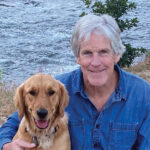From the Editor: September/October
The Toe of Awakening
In the rush of this issue I took a break and waded into the Rogue River and soon got caught up rolling boulders out of the launching area in preparation for our annual whitewater race, the King of the Rogue. Water displacement makes it possible to move large boulders, and moving boulders is profoundly satisfying. But I got distracted thinking about the appropriate headline for Zainab Salbi’s cover story: Should it be “Take Control of Your Story!” or “Why Share Your Pain?” And so a boulder rolled over my big toe.
Aha! I had lost control of my story and could now share my pain. This was a teaching boulder!
The lesson was just beginning. That evening, while watching Netflix, I rolled over and a rib popped out of place—and I felt as if I had been skewered. I couldn’t lie down, couldn’t sleep, and when I finally did—and thus breathed deeply—I woke up with the pain reset to that perfect (expletive deleted) 10. After a few days I became leery of sleep because it meant waking up.
Meanwhile, I tried pretty much everything: adjustments, acupuncture, opioids, muscle relaxants, tennis balls, vibration, bodywork, dance . . . You name it. Everything helped, but nothing helped so much as the realization that about everyone I talked to had at some point felt as incapacitated as I was. My pain was mine—and excruciating—but it had visited pretty much everyone else. I got so much support from that kind of sharing that it wasn’t many more days before I woke up slightly better and soon much better.
Then I reread Salbi’s article (page 24) and the teaching boulder knocked me flat. The recounting of one woman’s ordeal—the atrocity that inspired Salbi to tell her own story of rape—is so painful to read that I had almost edited it out as inappropriate. But now I had to consider the possibility of waking up to such pain without being able to talk about it.
This magazine issue isn’t easy. Rabbi Rami chimed in early with an extra-long answer to a big question: “I’m writing to ask you how best to live my dying.” Meanwhile, we received the manuscript to Walking Each Other Home, a book of conversations between Ram Dass and Mirabai Bush. Ram Dass is often in pain and his only real release will be death. Yet he’s still learning from the experience and still teaching. (38) That book led, in turn, to a great conversation between Bush and our own Meggen Petersen. (60) Meanwhile, I visited an amazing new hospice at what had once been the grandest home in town. It’s probably better than dying at home. (96)
Then there’s Amber Bodily’s story about becoming a healer—a quest that started when confronted by the question “Don’t you want your son to live?” (48) And a longtime reader, Kellie Poulin-Kinnard, sent in a story about the stomach-churning fear she felt just knocking on the front door of her flight instructor neighbor. She wanted to learn “to fly upside down.” (28)
Why so much pain and death and fear? Because sharing breaks down the walls that trap us in such stuff. We have boulders to roll, people to heal, and planes to fly upside down! All this brings me to Mofwoofoo (whose name means “Don’t take yourself too seriously”). (42) Mofwoofoo could have settled into a comfortable retirement but chose instead to start an eco-community in Ecuador. It’s much more work, he says, but “I am surrounded by people I love!” And speaking of which, I’ll be at the Omega Institute (Sept 16-21) for Transformative Medicine, and Paul Sutherland will be speaking at the Parliament of the World’s Religions in Ontario, Canada (Nov 1-7). Join us!
Stephen Kiesling
steve@spiritualityhealth.com


